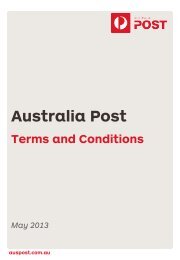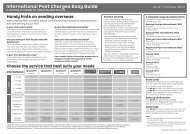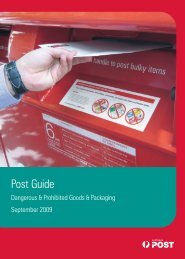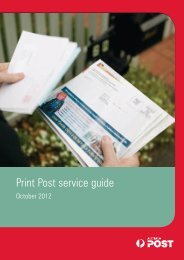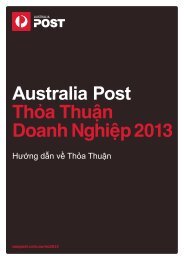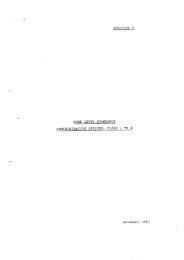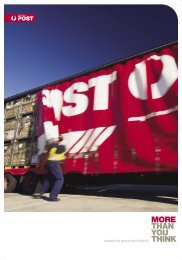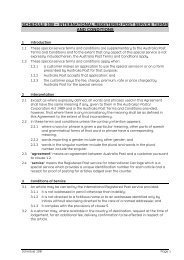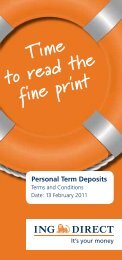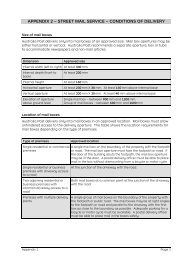Australia Post Annual Report 2008–09
Australia Post Annual Report 2008–09
Australia Post Annual Report 2008–09
Create successful ePaper yourself
Turn your PDF publications into a flip-book with our unique Google optimized e-Paper software.
Notes to and forming part of the Financial <strong>Report</strong> for the year ended 30 June 2009<br />
Cashflows are included in the cashflow<br />
statement on a gross basis and the GST<br />
component of cashflows arising from investing<br />
and financing activities – which is recoverable<br />
from, or payable to, the taxation authority –<br />
is classified as part of operating cashflows.<br />
Commitments and contingencies are disclosed<br />
inclusive of GST recoverable from, or payable<br />
to, the taxation authority.<br />
(r) Acquisition of assets<br />
Assets are recorded at cost on acquisition<br />
except as stated below. The cost of acquisition<br />
includes the fair value of assets transferred in<br />
exchange and liabilities undertaken. Financial<br />
assets are initially measured at their fair value<br />
plus transaction costs where appropriate.<br />
Assets acquired at no cost, or for nominal<br />
consideration, are initially recognised as<br />
assets and revenues at their fair value at<br />
the date of acquisition, unless acquired<br />
as a consequence of restructuring of<br />
administrative arrangements. In the latter<br />
case, assets are initially recognised as<br />
contributions by owners at the amounts<br />
at which they were recognised in the<br />
transferor authority’s accounts immediately<br />
before the restructuring.<br />
(s) Property, plant and equipment<br />
Property, plant and equipment are stated at<br />
historical cost less accumulated depreciation<br />
and any accumulated impairment losses. Such<br />
cost includes the cost of replacing parts that<br />
are eligible for capitalisation when the cost of<br />
replacing the parts is incurred. Similarly, when<br />
each major inspection is performed, its cost is<br />
recognised in the carrying amount of the plant<br />
and equipment as a replacement only if it is<br />
eligible for capitalisation. All other repairs and<br />
maintenance are recognised in the profit or<br />
loss as incurred.<br />
An item of property, plant or equipment is<br />
derecognised upon disposal or when no further<br />
future economic benefits are expected from<br />
its use or disposal. Any gain or loss arising on<br />
derecognition of the asset (calculated as the<br />
difference between the net disposal proceeds<br />
and the carrying amount of the asset) is<br />
included in profit or loss in the year in which<br />
the asset is derecognised.<br />
Depreciable property, plant and equipment<br />
assets are written off to their estimated<br />
residual values over their estimated useful lives<br />
using the straight-line method of depreciation.<br />
Depreciation rates (useful lives) and methods are<br />
reviewed annually and necessary adjustments<br />
are recognised in the current, or current and<br />
future reporting periods, as appropriate.<br />
66<br />
<strong>Australia</strong> <strong>Post</strong> <strong>Annual</strong> <strong>Report</strong> <strong>2008–09</strong> | Financial and statutory reports<br />
Depreciation rates applying to items in each<br />
class of depreciable asset are based on the<br />
following useful lives.<br />
Buildings –<br />
GPOs<br />
Buildings –<br />
other facilities<br />
Leasehold<br />
improvements<br />
2009 2008<br />
70<br />
years<br />
40–50<br />
years<br />
Lower<br />
of lease<br />
term and<br />
10 years<br />
Motor vehicles 3–10<br />
years<br />
Specialised plant<br />
and equipment<br />
Other plant and<br />
equipment<br />
10–20<br />
years<br />
3–10<br />
years<br />
70<br />
years<br />
40–50<br />
years<br />
Lower<br />
of lease<br />
term and<br />
10 years<br />
3–10<br />
years<br />
10–20<br />
years<br />
3–10<br />
years<br />
The aggregate amount of depreciation<br />
allocated for each class of asset during<br />
the reporting period is disclosed in note 3.<br />
(t) Investment properties<br />
Investment properties are measured initially at<br />
cost, including transaction costs. The carrying<br />
amount includes the cost of replacing part of<br />
an existing investment property at the time<br />
that cost is incurred if the recognition criteria<br />
are met, and excludes the costs of day-to-day<br />
servicing of an investment property.<br />
Subsequent to initial recognition, investment<br />
properties are stated at fair value, which is<br />
based on active market prices, adjusted if<br />
necessary, for any difference in the nature,<br />
location or condition of the specific asset at<br />
the balance sheet date. Gains or losses arising<br />
from changes in the fair values of investment<br />
properties are recognised in profit or loss in<br />
the year in which they arise.<br />
Investment properties are derecognised either<br />
when they have been disposed of or when the<br />
investment property is permanently withdrawn<br />
from use and no future economic benefit is<br />
expected from its disposal. Any gains or losses<br />
on the retirement or disposal of an investment<br />
property are recognised in profit or loss in the<br />
year of retirement or disposal.<br />
Transfers are made to investment property<br />
when there is a change in use, evidenced by<br />
ending of owner-occupation, commencement<br />
of an operating lease to another party or<br />
ending of construction or development.<br />
Transfers are made from investment property<br />
when, and only when, there is a change in<br />
use, evidenced by commencement of<br />
owner-occupation or commencement of<br />
development with a view to sale.<br />
For a transfer from investment property<br />
to owner-occupied property or inventories,<br />
the deemed cost of property for subsequent<br />
accounting is its fair value at the date of<br />
change in use. If the property occupied by<br />
the group as an owner-occupied property<br />
becomes an investment property, the group<br />
accounts for such property in accordance with<br />
the policy stated under Property, plant and<br />
equipment up to the date of change in use.<br />
When the group completes the construction or<br />
development of a self-constructed investment<br />
property, any difference between the fair value<br />
of the property at that date and its previous<br />
carrying amount is recognised in profit or loss.<br />
(u) Investments and other<br />
financial assets<br />
Investments and financial assets in the<br />
scope of AASB 139 Financial Instruments:<br />
Recognition and Measurement are categorised<br />
as either financial assets at fair value through<br />
profit or loss, loans and receivables, held-tomaturity<br />
investments, or available-for-sale<br />
financial assets. The classification depends on<br />
the purpose for which the investments were<br />
acquired. Designation is re-evaluated at each<br />
financial year end, but there are restrictions on<br />
classifying to other categories. When financial<br />
assets are recognised initially, they are<br />
measured at fair value, plus, in the case of<br />
assets not at fair value through profit or loss,<br />
directly attributable transactions costs.<br />
Recognition and derecognition<br />
All regular-way purchases and sales of<br />
financial assets are recognised on the trade<br />
date, ie the date on which the group commits to<br />
purchase the asset. Regular-way purchases or<br />
sales are purchases or sales of financial assets<br />
under contracts that require delivery of the<br />
assets within the period established generally<br />
by regulation or convention in the marketplace.<br />
Financial assets are derecognised when the<br />
right to receive cashflows from the financial<br />
assets has expired or been transferred.<br />
(i) Financial assets at fair value through<br />
profit or loss<br />
Financial assets classified as held for trading are<br />
included in the category “financial assets at fair<br />
value through profit or loss”. Financial assets<br />
are classified as held for trading if they are<br />
acquired for the purpose of selling in the near<br />
term with the intention of making a profit.<br />
Derivatives are also classified as held for trading<br />
unless they are designated as effective hedging<br />
instruments. Gains or losses on financial<br />
assets held for trading are recognised in profit<br />
or loss and the related assets are classified as<br />
current assets in the balance sheet.




